Business Environment Report: Analysis of TESCO, Virgin, and Oxfam
VerifiedAdded on 2020/06/03
|18
|4890
|95
Report
AI Summary
This report provides a comprehensive analysis of the business environment, focusing on TESCO, a leading UK multinational grocery and retail organization. It begins with an introduction to the concept of the business environment, encompassing internal and external factors that influence a company's operations. The report delves into different types of business enterprises, including public, private, and voluntary sectors, providing examples like TESCO, Virgin Group, and Oxfam. It examines their legal structures, aims, and scopes. A significant portion of the report is dedicated to TESCO, detailing its size, scope, vision, mission, and business objectives. Furthermore, the report includes a stakeholder analysis, categorizing stakeholders into internal (employees, managers, board of directors) and external (customers, stockholders, government, vendors) groups, and discussing their respective roles and influences on the company. The report also touches on the business environment, including PESTLE and SWOT analyses, and the impact of micro and macro factors. It concludes with a summary of the key findings and references used.
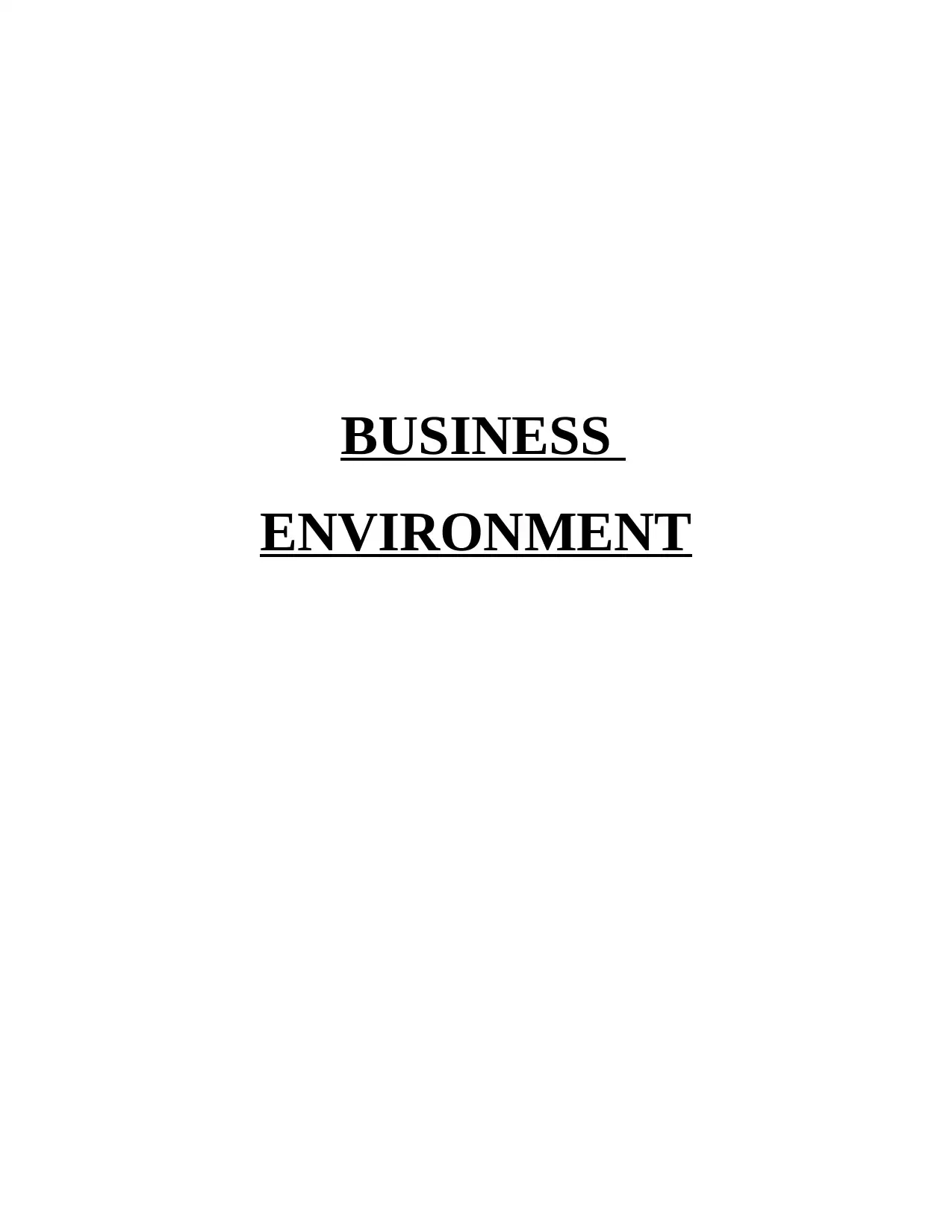
BUSINESS
ENVIRONMENT
ENVIRONMENT
Paraphrase This Document
Need a fresh take? Get an instant paraphrase of this document with our AI Paraphraser
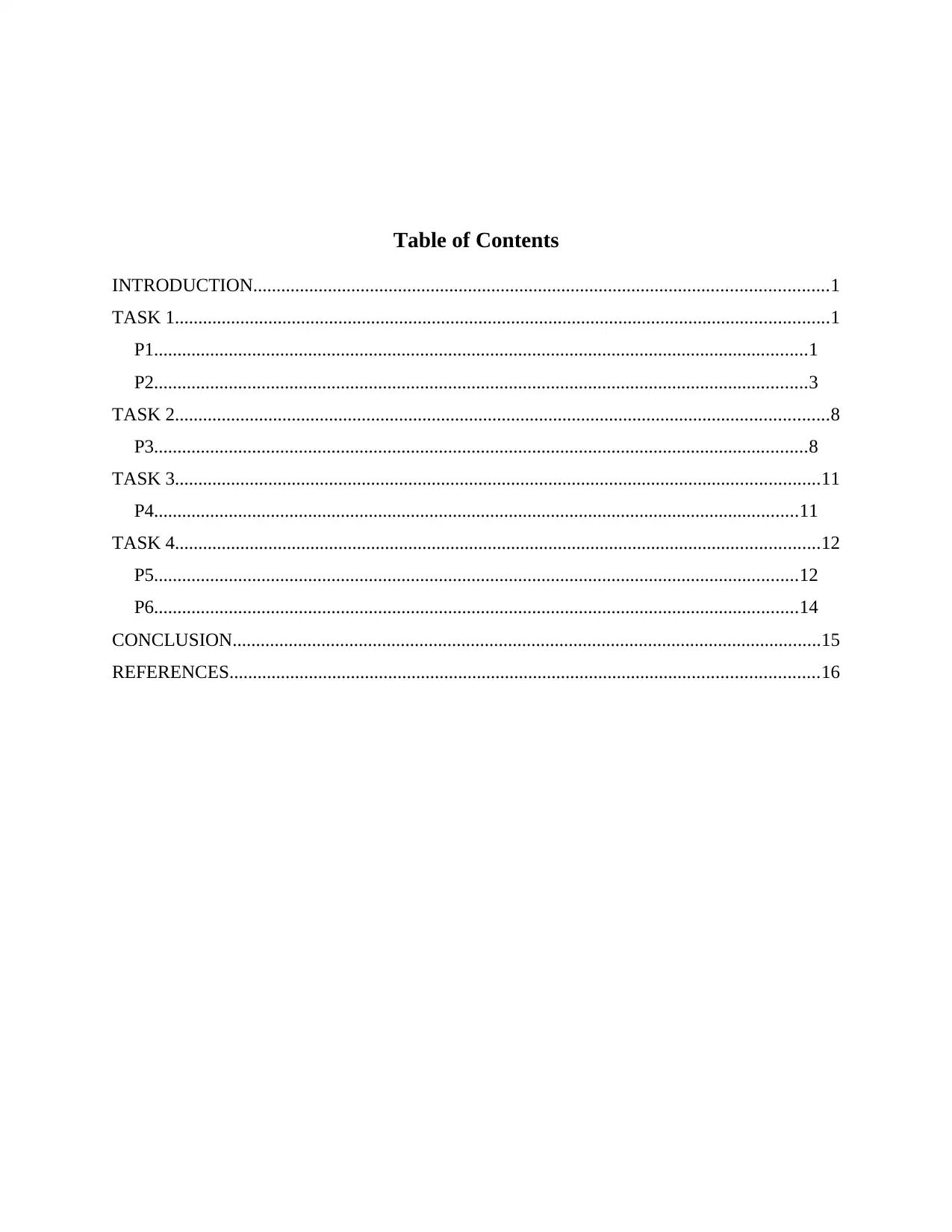
Table of Contents
INTRODUCTION...........................................................................................................................1
TASK 1............................................................................................................................................1
P1............................................................................................................................................1
P2............................................................................................................................................3
TASK 2............................................................................................................................................8
P3............................................................................................................................................8
TASK 3..........................................................................................................................................11
P4..........................................................................................................................................11
TASK 4..........................................................................................................................................12
P5..........................................................................................................................................12
P6..........................................................................................................................................14
CONCLUSION..............................................................................................................................15
REFERENCES..............................................................................................................................16
INTRODUCTION...........................................................................................................................1
TASK 1............................................................................................................................................1
P1............................................................................................................................................1
P2............................................................................................................................................3
TASK 2............................................................................................................................................8
P3............................................................................................................................................8
TASK 3..........................................................................................................................................11
P4..........................................................................................................................................11
TASK 4..........................................................................................................................................12
P5..........................................................................................................................................12
P6..........................................................................................................................................14
CONCLUSION..............................................................................................................................15
REFERENCES..............................................................................................................................16
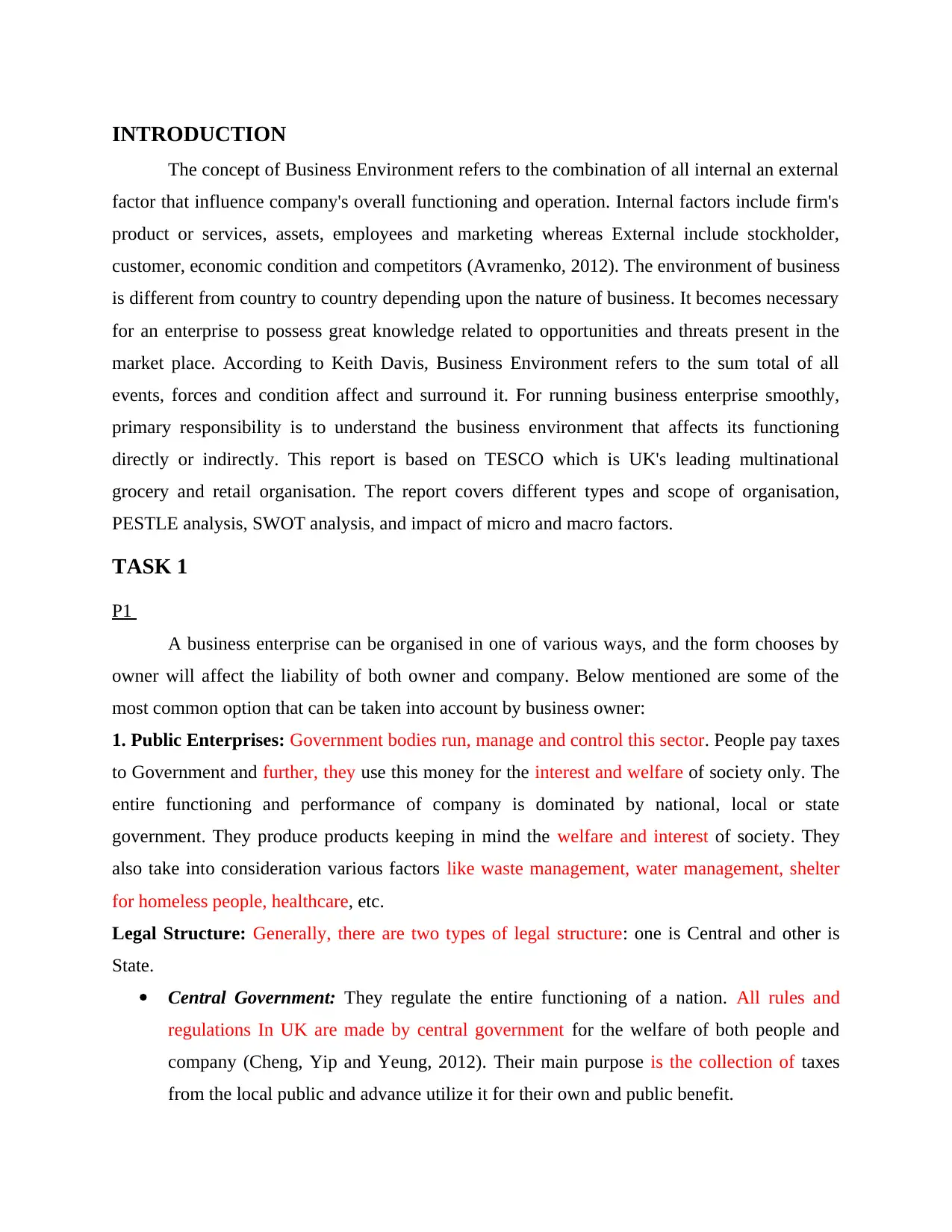
INTRODUCTION
The concept of Business Environment refers to the combination of all internal an external
factor that influence company's overall functioning and operation. Internal factors include firm's
product or services, assets, employees and marketing whereas External include stockholder,
customer, economic condition and competitors (Avramenko, 2012). The environment of business
is different from country to country depending upon the nature of business. It becomes necessary
for an enterprise to possess great knowledge related to opportunities and threats present in the
market place. According to Keith Davis, Business Environment refers to the sum total of all
events, forces and condition affect and surround it. For running business enterprise smoothly,
primary responsibility is to understand the business environment that affects its functioning
directly or indirectly. This report is based on TESCO which is UK's leading multinational
grocery and retail organisation. The report covers different types and scope of organisation,
PESTLE analysis, SWOT analysis, and impact of micro and macro factors.
TASK 1
P1
A business enterprise can be organised in one of various ways, and the form chooses by
owner will affect the liability of both owner and company. Below mentioned are some of the
most common option that can be taken into account by business owner:
1. Public Enterprises: Government bodies run, manage and control this sector. People pay taxes
to Government and further, they use this money for the interest and welfare of society only. The
entire functioning and performance of company is dominated by national, local or state
government. They produce products keeping in mind the welfare and interest of society. They
also take into consideration various factors like waste management, water management, shelter
for homeless people, healthcare, etc.
Legal Structure: Generally, there are two types of legal structure: one is Central and other is
State.
Central Government: They regulate the entire functioning of a nation. All rules and
regulations In UK are made by central government for the welfare of both people and
company (Cheng, Yip and Yeung, 2012). Their main purpose is the collection of taxes
from the local public and advance utilize it for their own and public benefit.
The concept of Business Environment refers to the combination of all internal an external
factor that influence company's overall functioning and operation. Internal factors include firm's
product or services, assets, employees and marketing whereas External include stockholder,
customer, economic condition and competitors (Avramenko, 2012). The environment of business
is different from country to country depending upon the nature of business. It becomes necessary
for an enterprise to possess great knowledge related to opportunities and threats present in the
market place. According to Keith Davis, Business Environment refers to the sum total of all
events, forces and condition affect and surround it. For running business enterprise smoothly,
primary responsibility is to understand the business environment that affects its functioning
directly or indirectly. This report is based on TESCO which is UK's leading multinational
grocery and retail organisation. The report covers different types and scope of organisation,
PESTLE analysis, SWOT analysis, and impact of micro and macro factors.
TASK 1
P1
A business enterprise can be organised in one of various ways, and the form chooses by
owner will affect the liability of both owner and company. Below mentioned are some of the
most common option that can be taken into account by business owner:
1. Public Enterprises: Government bodies run, manage and control this sector. People pay taxes
to Government and further, they use this money for the interest and welfare of society only. The
entire functioning and performance of company is dominated by national, local or state
government. They produce products keeping in mind the welfare and interest of society. They
also take into consideration various factors like waste management, water management, shelter
for homeless people, healthcare, etc.
Legal Structure: Generally, there are two types of legal structure: one is Central and other is
State.
Central Government: They regulate the entire functioning of a nation. All rules and
regulations In UK are made by central government for the welfare of both people and
company (Cheng, Yip and Yeung, 2012). Their main purpose is the collection of taxes
from the local public and advance utilize it for their own and public benefit.
⊘ This is a preview!⊘
Do you want full access?
Subscribe today to unlock all pages.

Trusted by 1+ million students worldwide
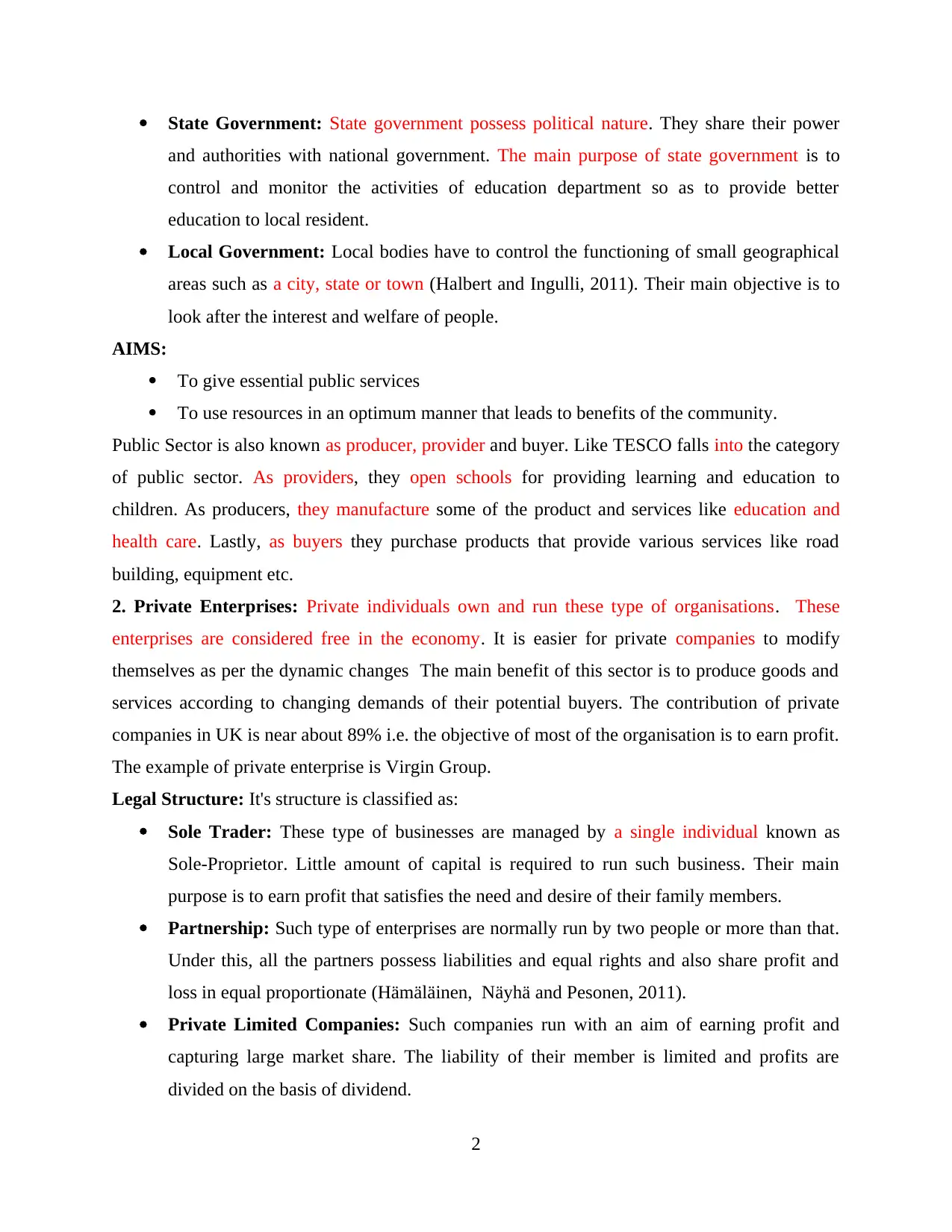
State Government: State government possess political nature. They share their power
and authorities with national government. The main purpose of state government is to
control and monitor the activities of education department so as to provide better
education to local resident.
Local Government: Local bodies have to control the functioning of small geographical
areas such as a city, state or town (Halbert and Ingulli, 2011). Their main objective is to
look after the interest and welfare of people.
AIMS:
To give essential public services
To use resources in an optimum manner that leads to benefits of the community.
Public Sector is also known as producer, provider and buyer. Like TESCO falls into the category
of public sector. As providers, they open schools for providing learning and education to
children. As producers, they manufacture some of the product and services like education and
health care. Lastly, as buyers they purchase products that provide various services like road
building, equipment etc.
2. Private Enterprises: Private individuals own and run these type of organisations. These
enterprises are considered free in the economy. It is easier for private companies to modify
themselves as per the dynamic changes The main benefit of this sector is to produce goods and
services according to changing demands of their potential buyers. The contribution of private
companies in UK is near about 89% i.e. the objective of most of the organisation is to earn profit.
The example of private enterprise is Virgin Group.
Legal Structure: It's structure is classified as:
Sole Trader: These type of businesses are managed by a single individual known as
Sole-Proprietor. Little amount of capital is required to run such business. Their main
purpose is to earn profit that satisfies the need and desire of their family members.
Partnership: Such type of enterprises are normally run by two people or more than that.
Under this, all the partners possess liabilities and equal rights and also share profit and
loss in equal proportionate (Hämäläinen, Näyhä and Pesonen, 2011).
Private Limited Companies: Such companies run with an aim of earning profit and
capturing large market share. The liability of their member is limited and profits are
divided on the basis of dividend.
2
and authorities with national government. The main purpose of state government is to
control and monitor the activities of education department so as to provide better
education to local resident.
Local Government: Local bodies have to control the functioning of small geographical
areas such as a city, state or town (Halbert and Ingulli, 2011). Their main objective is to
look after the interest and welfare of people.
AIMS:
To give essential public services
To use resources in an optimum manner that leads to benefits of the community.
Public Sector is also known as producer, provider and buyer. Like TESCO falls into the category
of public sector. As providers, they open schools for providing learning and education to
children. As producers, they manufacture some of the product and services like education and
health care. Lastly, as buyers they purchase products that provide various services like road
building, equipment etc.
2. Private Enterprises: Private individuals own and run these type of organisations. These
enterprises are considered free in the economy. It is easier for private companies to modify
themselves as per the dynamic changes The main benefit of this sector is to produce goods and
services according to changing demands of their potential buyers. The contribution of private
companies in UK is near about 89% i.e. the objective of most of the organisation is to earn profit.
The example of private enterprise is Virgin Group.
Legal Structure: It's structure is classified as:
Sole Trader: These type of businesses are managed by a single individual known as
Sole-Proprietor. Little amount of capital is required to run such business. Their main
purpose is to earn profit that satisfies the need and desire of their family members.
Partnership: Such type of enterprises are normally run by two people or more than that.
Under this, all the partners possess liabilities and equal rights and also share profit and
loss in equal proportionate (Hämäläinen, Näyhä and Pesonen, 2011).
Private Limited Companies: Such companies run with an aim of earning profit and
capturing large market share. The liability of their member is limited and profits are
divided on the basis of dividend.
2
Paraphrase This Document
Need a fresh take? Get an instant paraphrase of this document with our AI Paraphraser
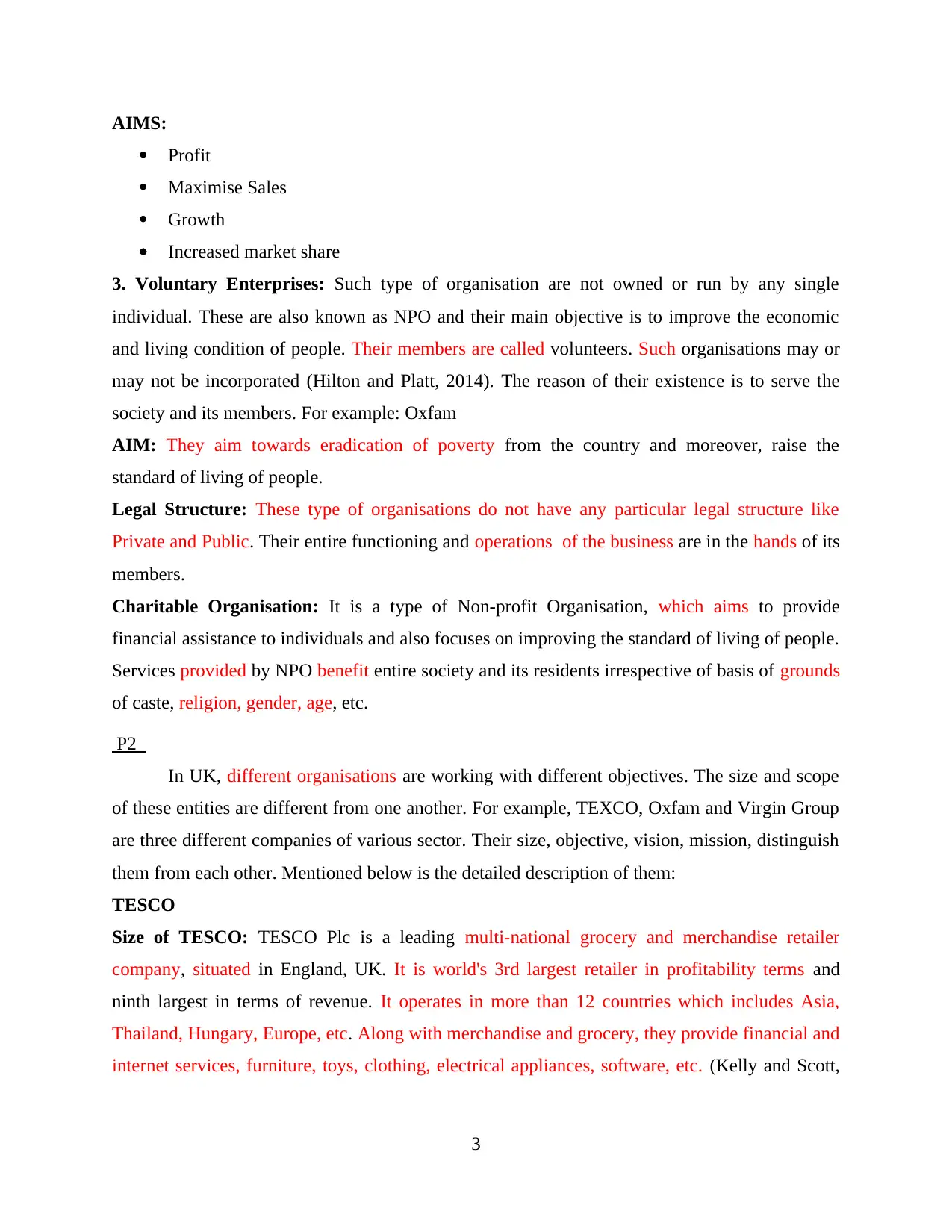
AIMS:
Profit
Maximise Sales
Growth
Increased market share
3. Voluntary Enterprises: Such type of organisation are not owned or run by any single
individual. These are also known as NPO and their main objective is to improve the economic
and living condition of people. Their members are called volunteers. Such organisations may or
may not be incorporated (Hilton and Platt, 2014). The reason of their existence is to serve the
society and its members. For example: Oxfam
AIM: They aim towards eradication of poverty from the country and moreover, raise the
standard of living of people.
Legal Structure: These type of organisations do not have any particular legal structure like
Private and Public. Their entire functioning and operations of the business are in the hands of its
members.
Charitable Organisation: It is a type of Non-profit Organisation, which aims to provide
financial assistance to individuals and also focuses on improving the standard of living of people.
Services provided by NPO benefit entire society and its residents irrespective of basis of grounds
of caste, religion, gender, age, etc.
P2
In UK, different organisations are working with different objectives. The size and scope
of these entities are different from one another. For example, TEXCO, Oxfam and Virgin Group
are three different companies of various sector. Their size, objective, vision, mission, distinguish
them from each other. Mentioned below is the detailed description of them:
TESCO
Size of TESCO: TESCO Plc is a leading multi-national grocery and merchandise retailer
company, situated in England, UK. It is world's 3rd largest retailer in profitability terms and
ninth largest in terms of revenue. It operates in more than 12 countries which includes Asia,
Thailand, Hungary, Europe, etc. Along with merchandise and grocery, they provide financial and
internet services, furniture, toys, clothing, electrical appliances, software, etc. (Kelly and Scott,
3
Profit
Maximise Sales
Growth
Increased market share
3. Voluntary Enterprises: Such type of organisation are not owned or run by any single
individual. These are also known as NPO and their main objective is to improve the economic
and living condition of people. Their members are called volunteers. Such organisations may or
may not be incorporated (Hilton and Platt, 2014). The reason of their existence is to serve the
society and its members. For example: Oxfam
AIM: They aim towards eradication of poverty from the country and moreover, raise the
standard of living of people.
Legal Structure: These type of organisations do not have any particular legal structure like
Private and Public. Their entire functioning and operations of the business are in the hands of its
members.
Charitable Organisation: It is a type of Non-profit Organisation, which aims to provide
financial assistance to individuals and also focuses on improving the standard of living of people.
Services provided by NPO benefit entire society and its residents irrespective of basis of grounds
of caste, religion, gender, age, etc.
P2
In UK, different organisations are working with different objectives. The size and scope
of these entities are different from one another. For example, TEXCO, Oxfam and Virgin Group
are three different companies of various sector. Their size, objective, vision, mission, distinguish
them from each other. Mentioned below is the detailed description of them:
TESCO
Size of TESCO: TESCO Plc is a leading multi-national grocery and merchandise retailer
company, situated in England, UK. It is world's 3rd largest retailer in profitability terms and
ninth largest in terms of revenue. It operates in more than 12 countries which includes Asia,
Thailand, Hungary, Europe, etc. Along with merchandise and grocery, they provide financial and
internet services, furniture, toys, clothing, electrical appliances, software, etc. (Kelly and Scott,
3
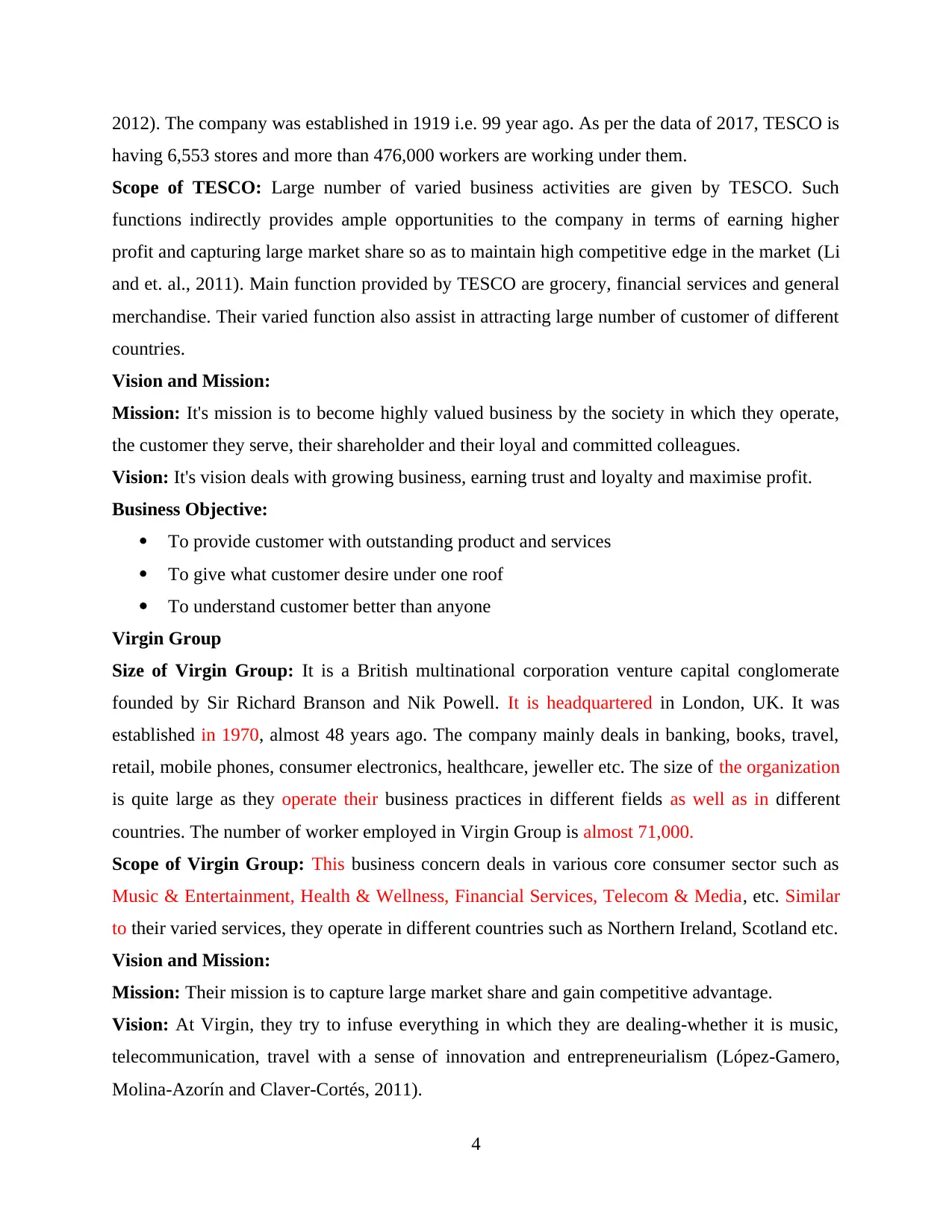
2012). The company was established in 1919 i.e. 99 year ago. As per the data of 2017, TESCO is
having 6,553 stores and more than 476,000 workers are working under them.
Scope of TESCO: Large number of varied business activities are given by TESCO. Such
functions indirectly provides ample opportunities to the company in terms of earning higher
profit and capturing large market share so as to maintain high competitive edge in the market (Li
and et. al., 2011). Main function provided by TESCO are grocery, financial services and general
merchandise. Their varied function also assist in attracting large number of customer of different
countries.
Vision and Mission:
Mission: It's mission is to become highly valued business by the society in which they operate,
the customer they serve, their shareholder and their loyal and committed colleagues.
Vision: It's vision deals with growing business, earning trust and loyalty and maximise profit.
Business Objective:
To provide customer with outstanding product and services
To give what customer desire under one roof
To understand customer better than anyone
Virgin Group
Size of Virgin Group: It is a British multinational corporation venture capital conglomerate
founded by Sir Richard Branson and Nik Powell. It is headquartered in London, UK. It was
established in 1970, almost 48 years ago. The company mainly deals in banking, books, travel,
retail, mobile phones, consumer electronics, healthcare, jeweller etc. The size of the organization
is quite large as they operate their business practices in different fields as well as in different
countries. The number of worker employed in Virgin Group is almost 71,000.
Scope of Virgin Group: This business concern deals in various core consumer sector such as
Music & Entertainment, Health & Wellness, Financial Services, Telecom & Media, etc. Similar
to their varied services, they operate in different countries such as Northern Ireland, Scotland etc.
Vision and Mission:
Mission: Their mission is to capture large market share and gain competitive advantage.
Vision: At Virgin, they try to infuse everything in which they are dealing-whether it is music,
telecommunication, travel with a sense of innovation and entrepreneurialism (López-Gamero,
Molina-Azorín and Claver-Cortés, 2011).
4
having 6,553 stores and more than 476,000 workers are working under them.
Scope of TESCO: Large number of varied business activities are given by TESCO. Such
functions indirectly provides ample opportunities to the company in terms of earning higher
profit and capturing large market share so as to maintain high competitive edge in the market (Li
and et. al., 2011). Main function provided by TESCO are grocery, financial services and general
merchandise. Their varied function also assist in attracting large number of customer of different
countries.
Vision and Mission:
Mission: It's mission is to become highly valued business by the society in which they operate,
the customer they serve, their shareholder and their loyal and committed colleagues.
Vision: It's vision deals with growing business, earning trust and loyalty and maximise profit.
Business Objective:
To provide customer with outstanding product and services
To give what customer desire under one roof
To understand customer better than anyone
Virgin Group
Size of Virgin Group: It is a British multinational corporation venture capital conglomerate
founded by Sir Richard Branson and Nik Powell. It is headquartered in London, UK. It was
established in 1970, almost 48 years ago. The company mainly deals in banking, books, travel,
retail, mobile phones, consumer electronics, healthcare, jeweller etc. The size of the organization
is quite large as they operate their business practices in different fields as well as in different
countries. The number of worker employed in Virgin Group is almost 71,000.
Scope of Virgin Group: This business concern deals in various core consumer sector such as
Music & Entertainment, Health & Wellness, Financial Services, Telecom & Media, etc. Similar
to their varied services, they operate in different countries such as Northern Ireland, Scotland etc.
Vision and Mission:
Mission: Their mission is to capture large market share and gain competitive advantage.
Vision: At Virgin, they try to infuse everything in which they are dealing-whether it is music,
telecommunication, travel with a sense of innovation and entrepreneurialism (López-Gamero,
Molina-Azorín and Claver-Cortés, 2011).
4
⊘ This is a preview!⊘
Do you want full access?
Subscribe today to unlock all pages.

Trusted by 1+ million students worldwide
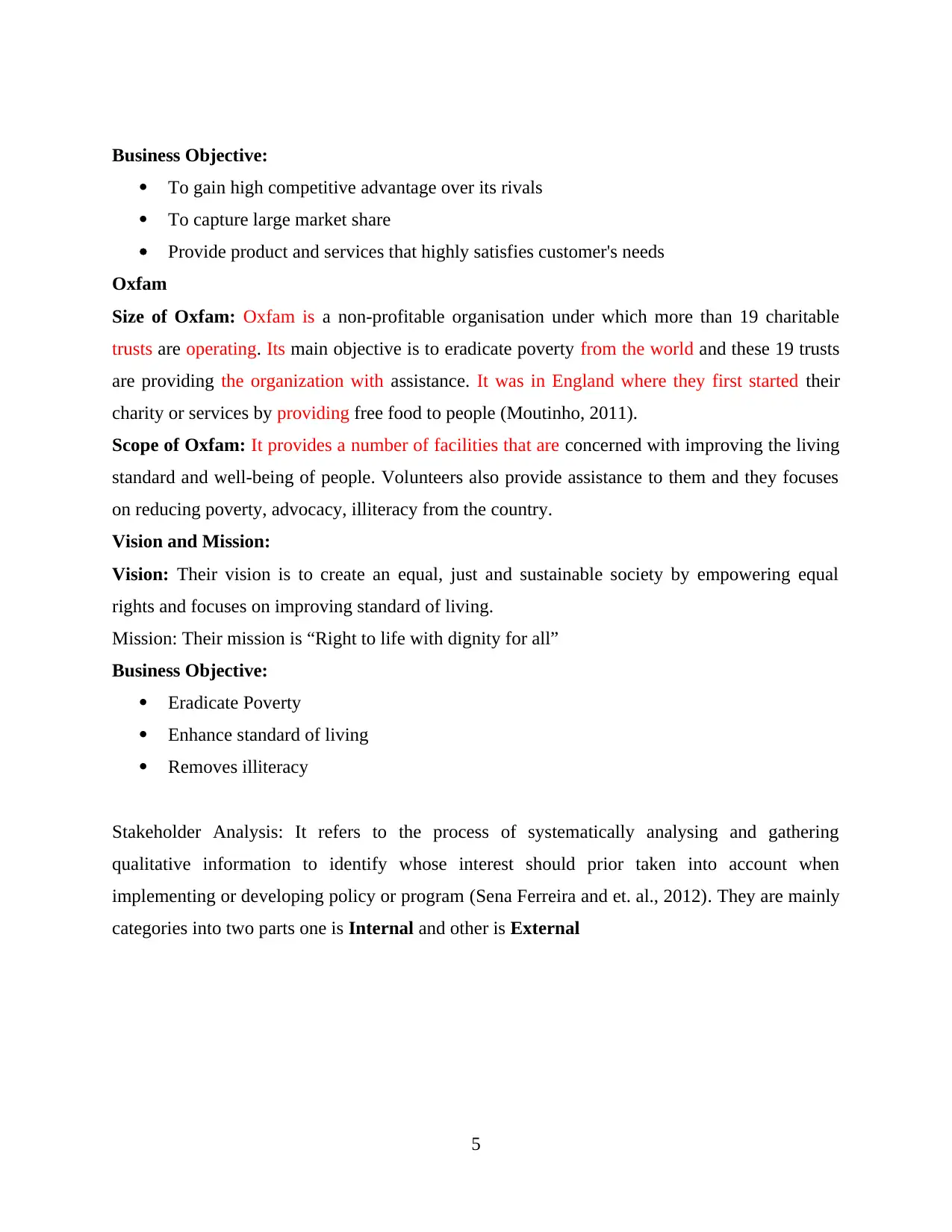
Business Objective:
To gain high competitive advantage over its rivals
To capture large market share
Provide product and services that highly satisfies customer's needs
Oxfam
Size of Oxfam: Oxfam is a non-profitable organisation under which more than 19 charitable
trusts are operating. Its main objective is to eradicate poverty from the world and these 19 trusts
are providing the organization with assistance. It was in England where they first started their
charity or services by providing free food to people (Moutinho, 2011).
Scope of Oxfam: It provides a number of facilities that are concerned with improving the living
standard and well-being of people. Volunteers also provide assistance to them and they focuses
on reducing poverty, advocacy, illiteracy from the country.
Vision and Mission:
Vision: Their vision is to create an equal, just and sustainable society by empowering equal
rights and focuses on improving standard of living.
Mission: Their mission is “Right to life with dignity for all”
Business Objective:
Eradicate Poverty
Enhance standard of living
Removes illiteracy
Stakeholder Analysis: It refers to the process of systematically analysing and gathering
qualitative information to identify whose interest should prior taken into account when
implementing or developing policy or program (Sena Ferreira and et. al., 2012). They are mainly
categories into two parts one is Internal and other is External
5
To gain high competitive advantage over its rivals
To capture large market share
Provide product and services that highly satisfies customer's needs
Oxfam
Size of Oxfam: Oxfam is a non-profitable organisation under which more than 19 charitable
trusts are operating. Its main objective is to eradicate poverty from the world and these 19 trusts
are providing the organization with assistance. It was in England where they first started their
charity or services by providing free food to people (Moutinho, 2011).
Scope of Oxfam: It provides a number of facilities that are concerned with improving the living
standard and well-being of people. Volunteers also provide assistance to them and they focuses
on reducing poverty, advocacy, illiteracy from the country.
Vision and Mission:
Vision: Their vision is to create an equal, just and sustainable society by empowering equal
rights and focuses on improving standard of living.
Mission: Their mission is “Right to life with dignity for all”
Business Objective:
Eradicate Poverty
Enhance standard of living
Removes illiteracy
Stakeholder Analysis: It refers to the process of systematically analysing and gathering
qualitative information to identify whose interest should prior taken into account when
implementing or developing policy or program (Sena Ferreira and et. al., 2012). They are mainly
categories into two parts one is Internal and other is External
5
Paraphrase This Document
Need a fresh take? Get an instant paraphrase of this document with our AI Paraphraser
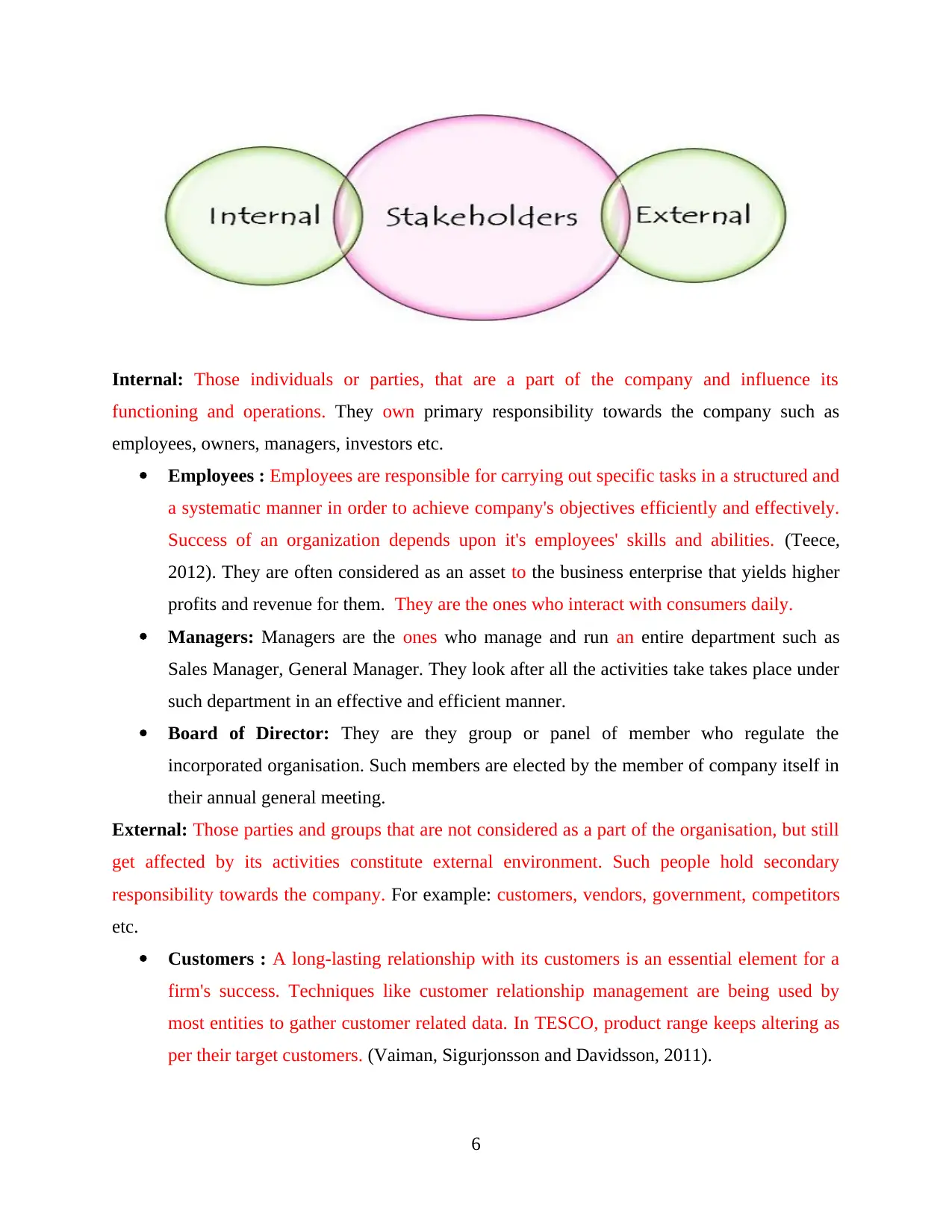
Internal: Those individuals or parties, that are a part of the company and influence its
functioning and operations. They own primary responsibility towards the company such as
employees, owners, managers, investors etc.
Employees : Employees are responsible for carrying out specific tasks in a structured and
a systematic manner in order to achieve company's objectives efficiently and effectively.
Success of an organization depends upon it's employees' skills and abilities. (Teece,
2012). They are often considered as an asset to the business enterprise that yields higher
profits and revenue for them. They are the ones who interact with consumers daily.
Managers: Managers are the ones who manage and run an entire department such as
Sales Manager, General Manager. They look after all the activities take takes place under
such department in an effective and efficient manner.
Board of Director: They are they group or panel of member who regulate the
incorporated organisation. Such members are elected by the member of company itself in
their annual general meeting.
External: Those parties and groups that are not considered as a part of the organisation, but still
get affected by its activities constitute external environment. Such people hold secondary
responsibility towards the company. For example: customers, vendors, government, competitors
etc.
Customers : A long-lasting relationship with its customers is an essential element for a
firm's success. Techniques like customer relationship management are being used by
most entities to gather customer related data. In TESCO, product range keeps altering as
per their target customers. (Vaiman, Sigurjonsson and Davidsson, 2011).
6
functioning and operations. They own primary responsibility towards the company such as
employees, owners, managers, investors etc.
Employees : Employees are responsible for carrying out specific tasks in a structured and
a systematic manner in order to achieve company's objectives efficiently and effectively.
Success of an organization depends upon it's employees' skills and abilities. (Teece,
2012). They are often considered as an asset to the business enterprise that yields higher
profits and revenue for them. They are the ones who interact with consumers daily.
Managers: Managers are the ones who manage and run an entire department such as
Sales Manager, General Manager. They look after all the activities take takes place under
such department in an effective and efficient manner.
Board of Director: They are they group or panel of member who regulate the
incorporated organisation. Such members are elected by the member of company itself in
their annual general meeting.
External: Those parties and groups that are not considered as a part of the organisation, but still
get affected by its activities constitute external environment. Such people hold secondary
responsibility towards the company. For example: customers, vendors, government, competitors
etc.
Customers : A long-lasting relationship with its customers is an essential element for a
firm's success. Techniques like customer relationship management are being used by
most entities to gather customer related data. In TESCO, product range keeps altering as
per their target customers. (Vaiman, Sigurjonsson and Davidsson, 2011).
6
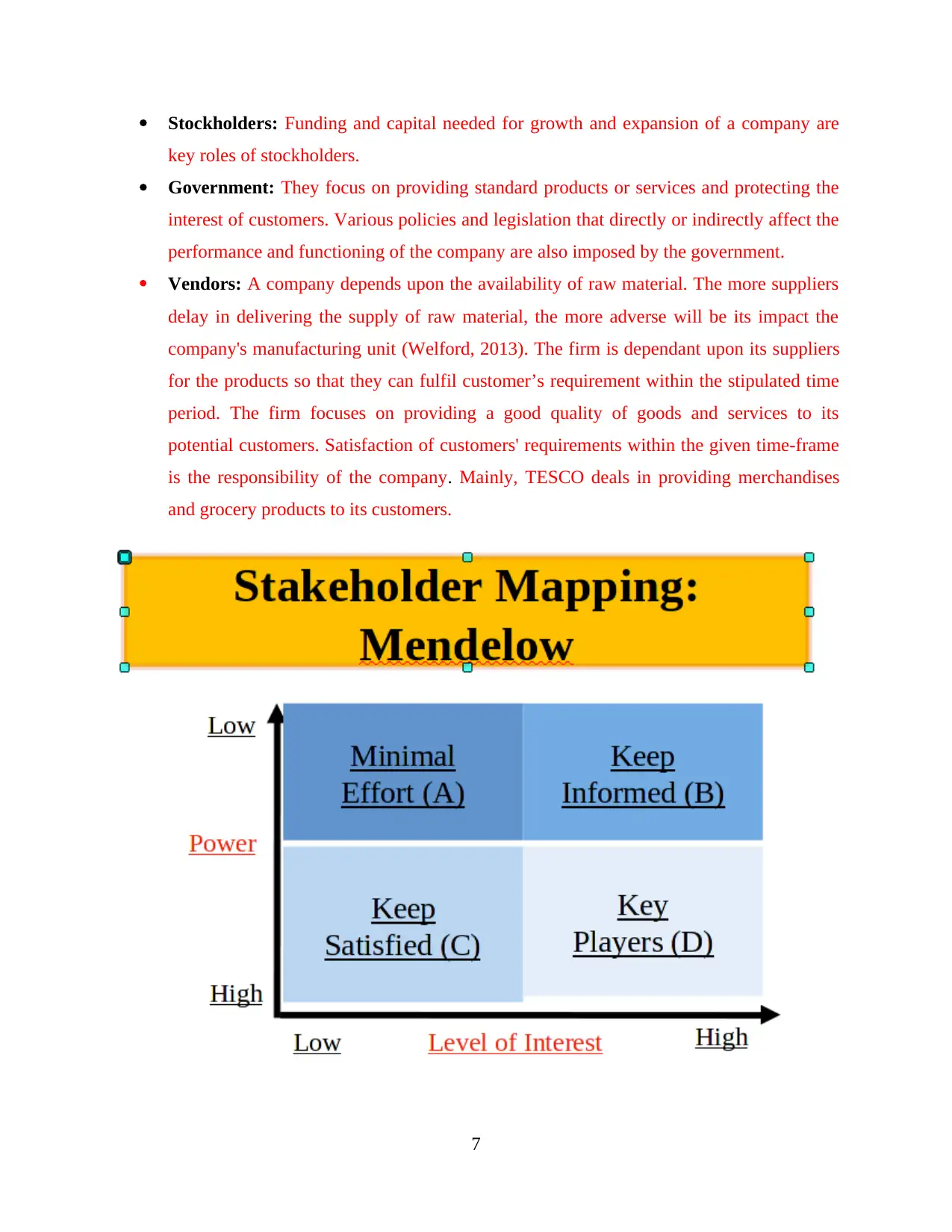
Stockholders: Funding and capital needed for growth and expansion of a company are
key roles of stockholders.
Government: They focus on providing standard products or services and protecting the
interest of customers. Various policies and legislation that directly or indirectly affect the
performance and functioning of the company are also imposed by the government.
Vendors: A company depends upon the availability of raw material. The more suppliers
delay in delivering the supply of raw material, the more adverse will be its impact the
company's manufacturing unit (Welford, 2013). The firm is dependant upon its suppliers
for the products so that they can fulfil customer’s requirement within the stipulated time
period. The firm focuses on providing a good quality of goods and services to its
potential customers. Satisfaction of customers' requirements within the given time-frame
is the responsibility of the company. Mainly, TESCO deals in providing merchandises
and grocery products to its customers.
7
key roles of stockholders.
Government: They focus on providing standard products or services and protecting the
interest of customers. Various policies and legislation that directly or indirectly affect the
performance and functioning of the company are also imposed by the government.
Vendors: A company depends upon the availability of raw material. The more suppliers
delay in delivering the supply of raw material, the more adverse will be its impact the
company's manufacturing unit (Welford, 2013). The firm is dependant upon its suppliers
for the products so that they can fulfil customer’s requirement within the stipulated time
period. The firm focuses on providing a good quality of goods and services to its
potential customers. Satisfaction of customers' requirements within the given time-frame
is the responsibility of the company. Mainly, TESCO deals in providing merchandises
and grocery products to its customers.
7
⊘ This is a preview!⊘
Do you want full access?
Subscribe today to unlock all pages.

Trusted by 1+ million students worldwide
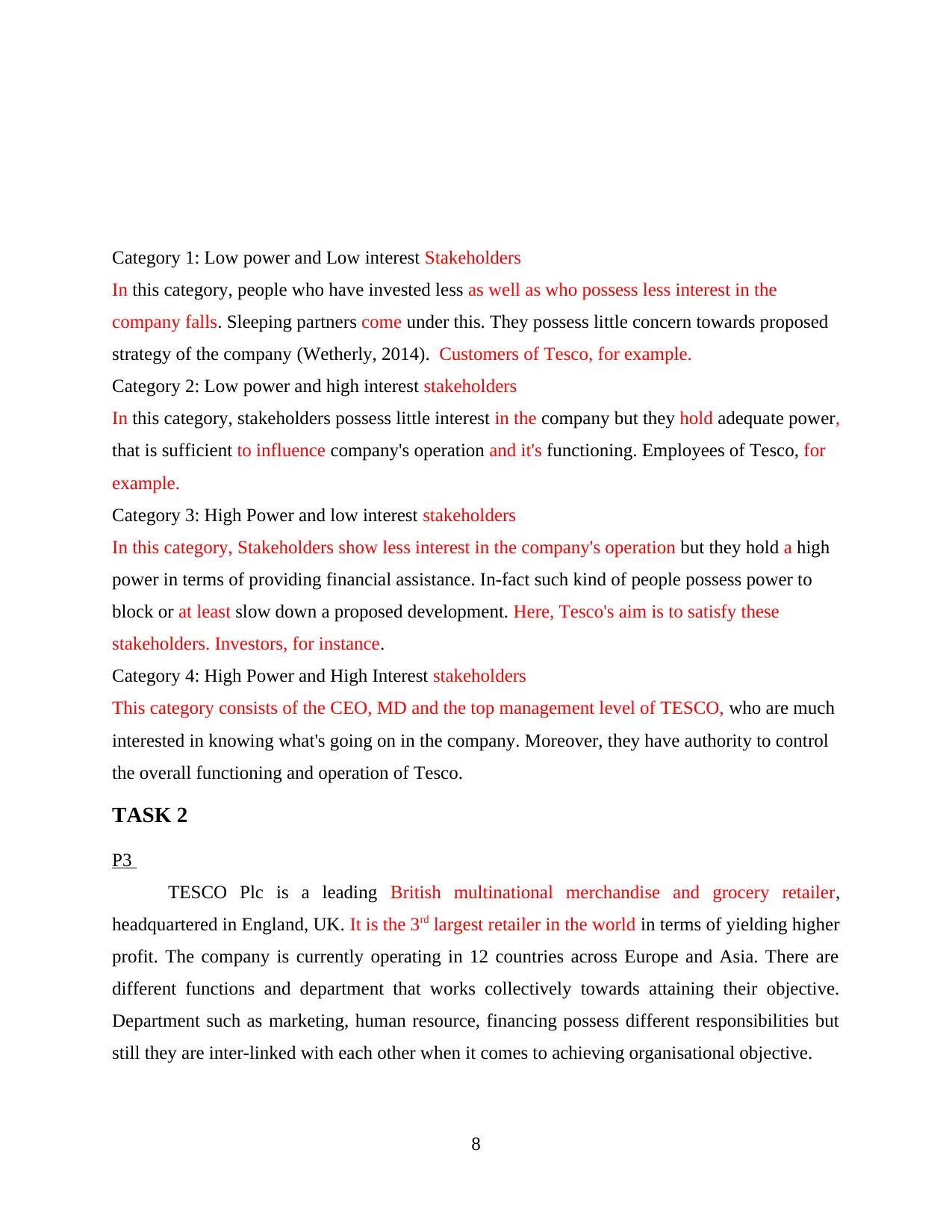
Category 1: Low power and Low interest Stakeholders
In this category, people who have invested less as well as who possess less interest in the
company falls. Sleeping partners come under this. They possess little concern towards proposed
strategy of the company (Wetherly, 2014). Customers of Tesco, for example.
Category 2: Low power and high interest stakeholders
In this category, stakeholders possess little interest in the company but they hold adequate power,
that is sufficient to influence company's operation and it's functioning. Employees of Tesco, for
example.
Category 3: High Power and low interest stakeholders
In this category, Stakeholders show less interest in the company's operation but they hold a high
power in terms of providing financial assistance. In-fact such kind of people possess power to
block or at least slow down a proposed development. Here, Tesco's aim is to satisfy these
stakeholders. Investors, for instance.
Category 4: High Power and High Interest stakeholders
This category consists of the CEO, MD and the top management level of TESCO, who are much
interested in knowing what's going on in the company. Moreover, they have authority to control
the overall functioning and operation of Tesco.
TASK 2
P3
TESCO Plc is a leading British multinational merchandise and grocery retailer,
headquartered in England, UK. It is the 3rd largest retailer in the world in terms of yielding higher
profit. The company is currently operating in 12 countries across Europe and Asia. There are
different functions and department that works collectively towards attaining their objective.
Department such as marketing, human resource, financing possess different responsibilities but
still they are inter-linked with each other when it comes to achieving organisational objective.
8
In this category, people who have invested less as well as who possess less interest in the
company falls. Sleeping partners come under this. They possess little concern towards proposed
strategy of the company (Wetherly, 2014). Customers of Tesco, for example.
Category 2: Low power and high interest stakeholders
In this category, stakeholders possess little interest in the company but they hold adequate power,
that is sufficient to influence company's operation and it's functioning. Employees of Tesco, for
example.
Category 3: High Power and low interest stakeholders
In this category, Stakeholders show less interest in the company's operation but they hold a high
power in terms of providing financial assistance. In-fact such kind of people possess power to
block or at least slow down a proposed development. Here, Tesco's aim is to satisfy these
stakeholders. Investors, for instance.
Category 4: High Power and High Interest stakeholders
This category consists of the CEO, MD and the top management level of TESCO, who are much
interested in knowing what's going on in the company. Moreover, they have authority to control
the overall functioning and operation of Tesco.
TASK 2
P3
TESCO Plc is a leading British multinational merchandise and grocery retailer,
headquartered in England, UK. It is the 3rd largest retailer in the world in terms of yielding higher
profit. The company is currently operating in 12 countries across Europe and Asia. There are
different functions and department that works collectively towards attaining their objective.
Department such as marketing, human resource, financing possess different responsibilities but
still they are inter-linked with each other when it comes to achieving organisational objective.
8
Paraphrase This Document
Need a fresh take? Get an instant paraphrase of this document with our AI Paraphraser
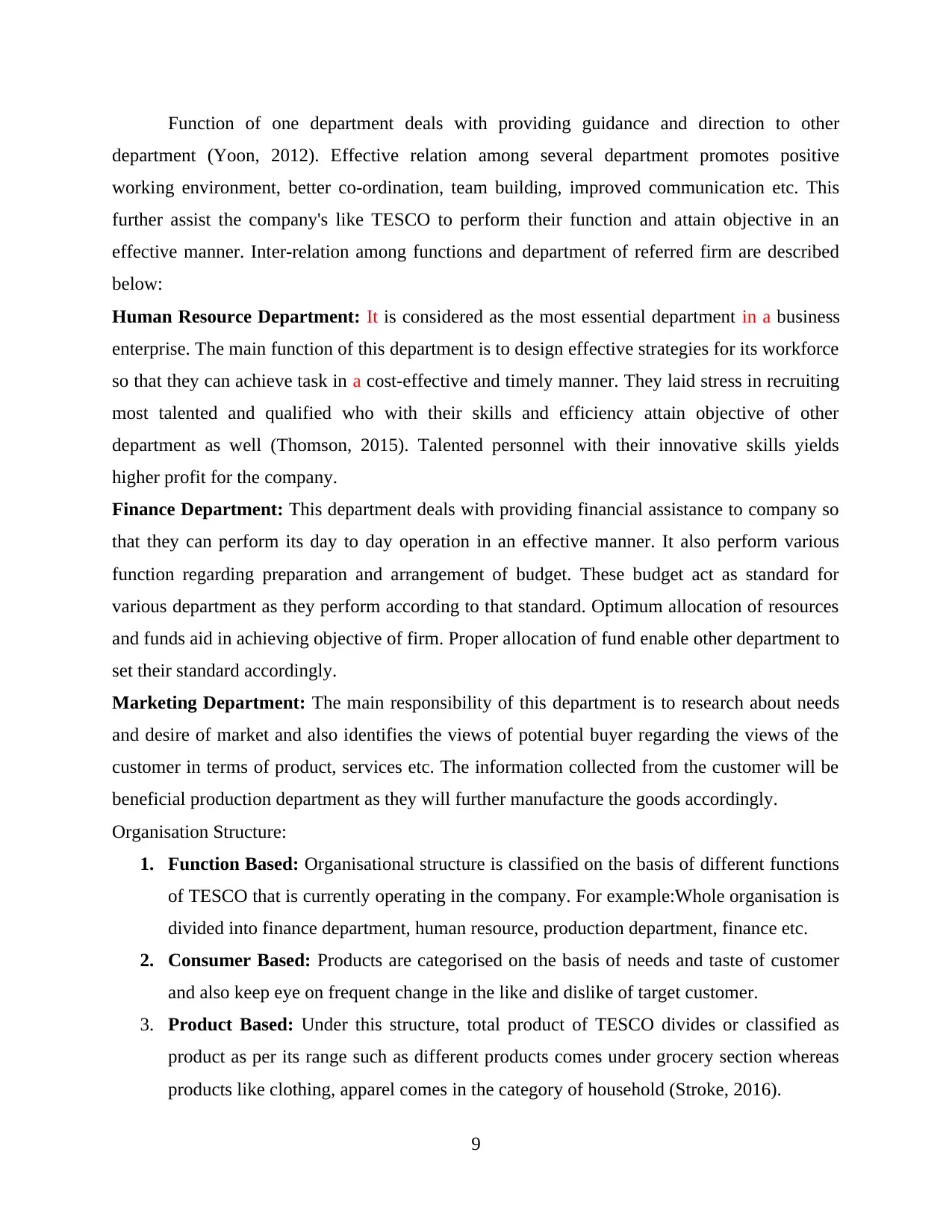
Function of one department deals with providing guidance and direction to other
department (Yoon, 2012). Effective relation among several department promotes positive
working environment, better co-ordination, team building, improved communication etc. This
further assist the company's like TESCO to perform their function and attain objective in an
effective manner. Inter-relation among functions and department of referred firm are described
below:
Human Resource Department: It is considered as the most essential department in a business
enterprise. The main function of this department is to design effective strategies for its workforce
so that they can achieve task in a cost-effective and timely manner. They laid stress in recruiting
most talented and qualified who with their skills and efficiency attain objective of other
department as well (Thomson, 2015). Talented personnel with their innovative skills yields
higher profit for the company.
Finance Department: This department deals with providing financial assistance to company so
that they can perform its day to day operation in an effective manner. It also perform various
function regarding preparation and arrangement of budget. These budget act as standard for
various department as they perform according to that standard. Optimum allocation of resources
and funds aid in achieving objective of firm. Proper allocation of fund enable other department to
set their standard accordingly.
Marketing Department: The main responsibility of this department is to research about needs
and desire of market and also identifies the views of potential buyer regarding the views of the
customer in terms of product, services etc. The information collected from the customer will be
beneficial production department as they will further manufacture the goods accordingly.
Organisation Structure:
1. Function Based: Organisational structure is classified on the basis of different functions
of TESCO that is currently operating in the company. For example:Whole organisation is
divided into finance department, human resource, production department, finance etc.
2. Consumer Based: Products are categorised on the basis of needs and taste of customer
and also keep eye on frequent change in the like and dislike of target customer.
3. Product Based: Under this structure, total product of TESCO divides or classified as
product as per its range such as different products comes under grocery section whereas
products like clothing, apparel comes in the category of household (Stroke, 2016).
9
department (Yoon, 2012). Effective relation among several department promotes positive
working environment, better co-ordination, team building, improved communication etc. This
further assist the company's like TESCO to perform their function and attain objective in an
effective manner. Inter-relation among functions and department of referred firm are described
below:
Human Resource Department: It is considered as the most essential department in a business
enterprise. The main function of this department is to design effective strategies for its workforce
so that they can achieve task in a cost-effective and timely manner. They laid stress in recruiting
most talented and qualified who with their skills and efficiency attain objective of other
department as well (Thomson, 2015). Talented personnel with their innovative skills yields
higher profit for the company.
Finance Department: This department deals with providing financial assistance to company so
that they can perform its day to day operation in an effective manner. It also perform various
function regarding preparation and arrangement of budget. These budget act as standard for
various department as they perform according to that standard. Optimum allocation of resources
and funds aid in achieving objective of firm. Proper allocation of fund enable other department to
set their standard accordingly.
Marketing Department: The main responsibility of this department is to research about needs
and desire of market and also identifies the views of potential buyer regarding the views of the
customer in terms of product, services etc. The information collected from the customer will be
beneficial production department as they will further manufacture the goods accordingly.
Organisation Structure:
1. Function Based: Organisational structure is classified on the basis of different functions
of TESCO that is currently operating in the company. For example:Whole organisation is
divided into finance department, human resource, production department, finance etc.
2. Consumer Based: Products are categorised on the basis of needs and taste of customer
and also keep eye on frequent change in the like and dislike of target customer.
3. Product Based: Under this structure, total product of TESCO divides or classified as
product as per its range such as different products comes under grocery section whereas
products like clothing, apparel comes in the category of household (Stroke, 2016).
9
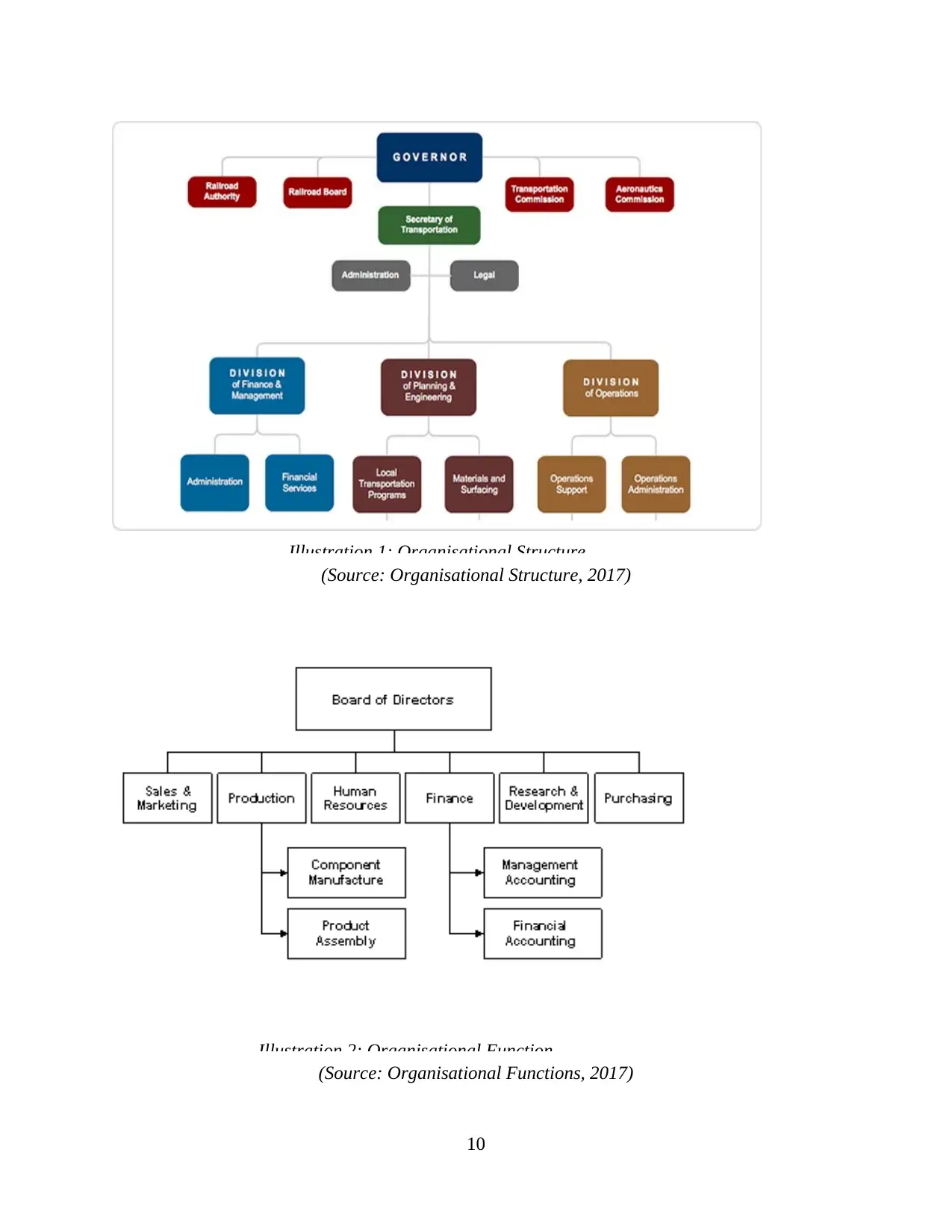
Illustration 1: Organisational Structure
(Source: Organisational Structure, 2017)
Illustration 2: Organisational Function
(Source: Organisational Functions, 2017)
10
(Source: Organisational Structure, 2017)
Illustration 2: Organisational Function
(Source: Organisational Functions, 2017)
10
⊘ This is a preview!⊘
Do you want full access?
Subscribe today to unlock all pages.

Trusted by 1+ million students worldwide
1 out of 18
Related Documents
Your All-in-One AI-Powered Toolkit for Academic Success.
+13062052269
info@desklib.com
Available 24*7 on WhatsApp / Email
![[object Object]](/_next/static/media/star-bottom.7253800d.svg)
Unlock your academic potential
Copyright © 2020–2025 A2Z Services. All Rights Reserved. Developed and managed by ZUCOL.





